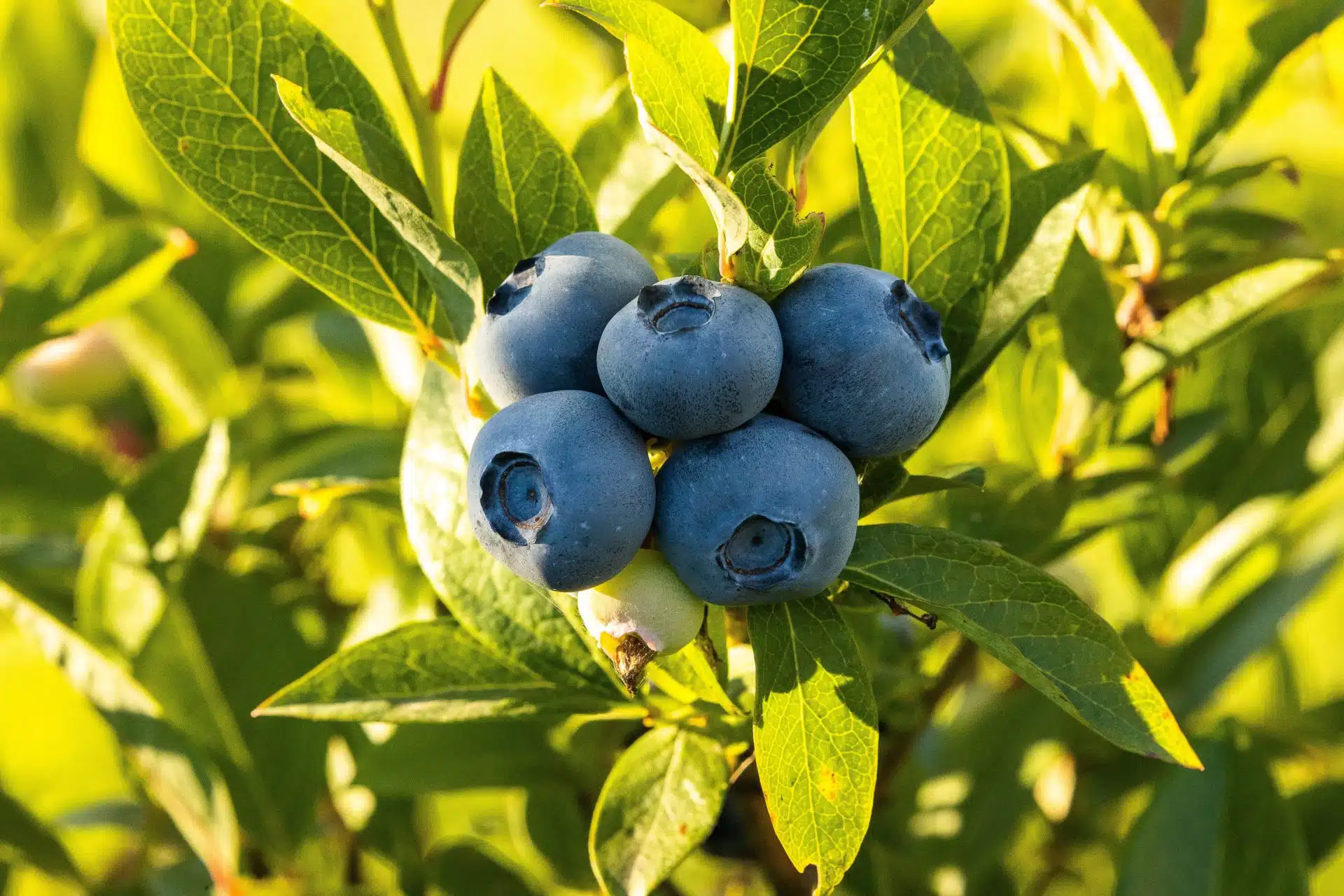Plants
Highbush blueberry
Vaccinium corymbosum

Blueberries are members of the heath family (Ericaceae). Vaccinium corymbosum has significant value for wildlife and for enhancement of our landscape. Its rhododendron and azalea cousins may have very showy flowers, but blueberries have the best fruit in the family (3,850 species). Highbush blueberry is native to eastern North America from Wisconsin to New Brunswick south to Florida and Texas. Blueberries have become naturalized in other states and provinces and feral populations have been reported as far away as Britain, Japan and New Zealand.
Vaccinium corymbosum was growing naturally in the area of Buttonbush Bog when The Holden Arboretum was established in the 1930s. In 1936 the crew dug two shrubs from Bradley-Everett Bog in Burton, Ohio, for inclusion in the Buttonbush Bog habitat planting. The only other native population of highbush blueberry at Holden is in Brainard Fen amidst a thriving thicket of poison sumac (Rhus vernix a.k.a. Toxicodendron vernix).
On the northeast side of Buttonbush Bog just south of the lookout on the opposite side from the observation deck is one of the highbush blueberries that John Aldrich dug from the existing native population and planted in 1940. It now measures about 10 feet tall by 15 feet wide and is shaded by a tulip tree (Liriodendron tulipifera). A younger specimen may be observed in the Myrtle S. Holden Wildflower Garden in the east end of the bog below the prairie section of the garden. Rescued by naturalist Bob Faber from the site of a development in Avon Lake in Lorain County in 1983, this (6’ x 5’) plant is now perched on a hummock surrounded by cranberries (Vaccinium macrocarpon).
There are two mass plantings of highbush blueberry along Sperry Road, south of the work road leading to the arborvitae collection and north of the Working Woods. In 2012 the conservation crew was cutting the buckthorn (Frangula alnus) along the adjacent woodline when they reported some natural regeneration of Vaccinium corymbosum. In 2013 any buckthorn that survived will be eradicated and Holden’s crew will plant shrubs of native provenance in the fall or the following spring, which may include shrubby dogwoods (Cornus racemosa, C. amomum, C. sericea), buttonbush (Cephalanthus occidentalis), swamp rose (Rosa palustris) and blueberries. Creatures great and small will have a higher quality habitat when these shrubs retake their place from the buckthorn that is currently dominant.
Blueberry fruits are eaten by a great number of songbirds including our beloved Eastern bluebirds and by a not so surprising number of mammals. After all, who doesn’t like blueberries? White-tailed deer browse the leaves, buds and shoots. Butterfly larvae, including brown elfin, woodland elfin, striped hairstreak and spring azure, feed on the foliage.
At Lantern Court there is a mature specimen, now 8’ x 9’, in the old cutting garden to the east of the main drive and the yellow buckeye (Aesculus flava). Originally planted by Warren Corning, it has had ripe fruit in the first week of July in past years, including 2012. The plants around Buttonbush Bog, Blueberry Pond and Foster Pond had no fruit in 2012 as April frosts destroyed their flowers, which opened on March 23. Some cultivars have been bred with more northern stock that are resistant to frost damage during bloom. The provenance of Corning’s blueberry is not known.
A member once asked for native blueberries at Holden’s Plant Sale, so in 2008 intern Mark Swapp and I collected fruit from our native plants and handed the seed to Greg Wright at the greenhouse. At the 2012 Plant Sale those blueberries sold like hotcakes. I would like to thank the buyers and remind them to be patient as it takes blueberries eight to 10 years to flower and bear fruit when raised from seed. Vegetatively propagated cultivars, of which there are seven in Holden’s collection, bear fruit much sooner, but it is recommended to pinch the flowers off of small young plants for the first year or two to allow them to put more energy into vegetative growth until they are fully established.
The pink-tinged small white flowers usually start into bloom during the fourth week of April and continue into mid-May, although this can vary widely subject to temperature. The fruits can start to ripen as early as late June or in August depending on the individual plant and variety.
Highbush blueberry has been bred with other blueberries including lowbush (V. angustifolium) to create “half-high” blueberries such as Vaccinium ‘Northblue’. Former Holden horticulturist Tom Yates planted five ‘Northblue’ on March 31, 1990 at Lantern Court on the west side of the parking lot. Two of the plants were moved to a more favorable location on the south side of the old cutting garden in May 2004 where they now measure 3’ x 5’. Nearby are planted Vaccinium corymbosum ‘Bluejay’, ‘Blueray’, ‘Coville’ and ‘Elliott’.
The foliage of Holden’s blueberries starts turning red in late September and usually lasts until the first week of November when it is typically orange-red. In the landscape they are useful in a shrub border, as a hedge, en masse and for naturalizing.




